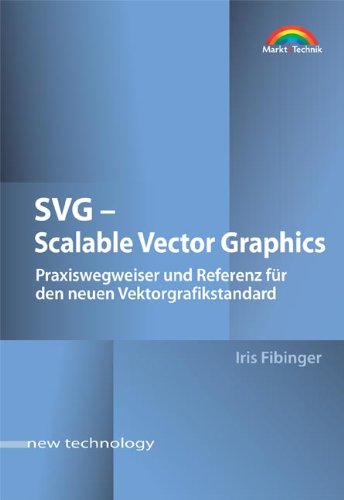1. SVG – Scalable Vector Graphics: Praxiswegweiser und Referenz für den neuen Vektorgrafikstandard by Iris Fibinger
This book is an essential guide for anyone looking to delve into the world of Scalable Vector Graphics. As the standard for vector graphics on the web, understanding SVG is crucial for contemporary web design. Fibinger provides readers with a comprehensive reference that addresses practical applications, making it suitable for both beginners and seasoned professionals. Her in-depth explanations simplify complex concepts, allowing designers to integrate SVG seamlessly into their projects. The detailing on application in web graphics guarantees that readers will find it an indispensable addition to their design library.
2. SVG Essentials by Eisenberg, J. David
SVG Essentials is a foundational book for those eager to understand vector graphics on the web. With a clear focus on the basics, Eisenberg equips readers with the skills to create stunning graphics that are both flexible and resolution-independent. This book does not only cover the how-to but dives into real-world applications of SVG in various scenarios. As the digital landscape constantly evolves, having this resource ensures that you’re up to date with the latest methods of integrating SVG into your designs. Each chapter is rich with examples, making this an engaging read for any aspiring digital artist.
3. SVG Text Layout: Words as Art by Bellamy-Royds, Amelia and Cagle, Kurt
Text as a visual element is often overlooked in graphic design, but in SVG Text Layout, the authors skillfully demonstrate how to use text artistically in your designs. This book serves as a bridge between textual information and visual aesthetics. With a focus on the unique capabilities of SVG for text rendering, readers will learn how to manipulate text to create compelling visual narratives. Rich with illustrations and practical tips, it is perfect for graphic designers looking to enhance their work by turning words into art.
4. Creating Infographics with Adobe Illustrator: Volume 3 by Jennifer Harder
This volume focuses on interactive infographics, an increasingly sought-after aspect of digital content creation. Harder’s book is packed with insights on leveraging Adobe Illustrator’s capabilities to enrich your infographics and engage viewers. With the rise of data visualization, understanding how to create compelling interactive content is paramount. The practical exercises provided are tailored to both beginner and advanced users, making it an excellent handbook for professionals aiming to elevate their design techniques.
5. Visualisieren von Geodaten mit SVG im Internet by Nicole Ueberschär and André M. Winter
This book introduces readers to the world of visualizing geographic data using SVG. It covers essential concepts, client-side interactions, and the dynamic aspects of SVG technology. With its clear explanations and practical examples, this resource is beneficial for anyone involved in geodata visualization. The authors’ focus on practical application will empower readers to utilize SVG to represent complex geographic information in a visually engaging manner.
6. Beginning XSLT by Jeni Tennison
This foundational text on XSLT is perfect for those who want to advance their web development skills. Tennison’s clear writing and practical examples simplify complex ideas, making it an accessible read for beginners. Understanding XSLT enhances a developer’s capability in transforming XML documents into styled documents, which is invaluable in today’s content-driven web. This book not only provides the basics but also illustrates its practical uses in real-world scenarios, ensuring you can apply what you learn immediately.
7. Beginning XSLT 2.0: From Novice to Professional by Jeni Tennison
Diving deeper into XSLT, this book builds on the foundational skills established in the previous volume. Tennison ensures that readers are not only learning the syntax but are also integrating these concepts into professional practices. The book’s focus on practical applications provides aspiring professionals flexibility and understanding through real-world examples, pushing them from novice to essential developer status quickly. It is a critical read for anyone looking to master XSLT 2.0 in a professional context.
8. Visualizing Information Using SVG and X3D by Vladimir Geroimenko and Chaomei Chen
This book is a profound guide on integrating both SVG and X3D technology to visualize complex information. The authors provide a thorough exploration of the techniques necessary for 3D visualizations on the web, extending the boundaries of traditional 2D graphics. Engaging and filled with illustrative examples, this book is perfect for professionals who need to present complex data with clarity and sophistication in modern web design.
9. SVG Drawing with HTML5 by Hussein Qutbi
This upcoming book is poised to be a fantastic resource for modern web developers looking to enhance their graphic design capabilities using HTML5 and SVG. Qutbi’s promising insights will aid readers in creating rich, interactive, and responsive graphics, making this essential for anyone involved in front-end development. Emphasizing simplicity while still covering intricate details, this book will undoubtedly bridge any gaps in understanding SVG drawing techniques.
10. Creating Infographics with Adobe Illustrator: Volume 1 by Jennifer Harder
With a focus on the fundamentals of infographic design, this book teaches readers the basics of creating eye-catching visuals using Adobe Illustrator. Harder’s approachable teaching style and practical exercises ensure that even those with little artistic background will feel confident in their design skills. This book not only teaches the tools necessary for creating infographics but also provides insights into what makes an infographic effective in conveying information, making it a must-read for aspiring designers.














































